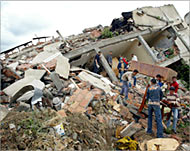Algeria shaken by aftershocks
Algerians were in a state of panic early Wednesday following a new tremor which came hours after Tuesday night’s aftershock which killed at least three people and injured about 200.
 |
|
Algerians are still clearing up |
There were no immediate reports of injuries or damage in Wednesday’s quake which measured 5.2 on the Richter scale.
But state radio said Tuesday’s tremor led to the collapse of several buildings in the towns of Zemmouri and Boumerdes east of Algiers. Zemmouri was the epicentre of last Wednesday’s quake, which devastated northern parts of the country killing 2,200 people.
Unconfirmed reports from witnesses said three people were killed as they searched through the rubble of their apartment building.
Rescue workers later recovered one of the missing three from the 15-storey building that was levelled in last’s week quake.
There were conflicting reports about the number of casualties with one French rescue worker putting the toll at nine.
Some officials said many of the injuries were due to people panicking and rushing out of their homes into the streets.
Officials urge calm
Authorities pleaded calm and said the quake was an aftershock from Wednesday’s quake, which measured at least 6.0 on the Richter scale.
The latest official toll from that quake is 2,218 dead and more than 9,000 injured.
Shock and grief turned into anger over the weekend, as Algerians accused the government of doing little to help the homeless. People said the government had turned a blind-eye to builders who cut corners in a quake-prone area.
Crowds shouted “assassin” and threw stones at President Abdelaziz Bouteflika as he toured affected areas.
Bouteflika has ordered an investigation into why so many buildings crumbled, state television reported.
Dozens of people have yet to be accounted for and are believed to be buried under the rubble. The body count looks likely to climb and the risk of disease spreading to those who survived looms.
Health workers across the Mediterranean coastal areas are working to prevent the outbreak of water-borne diseases among the 15,000 people left homeless.